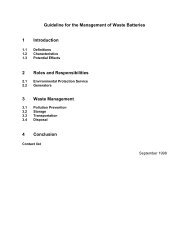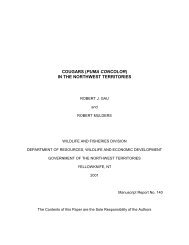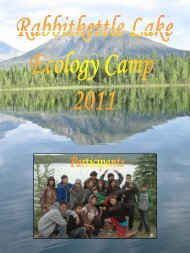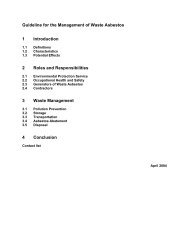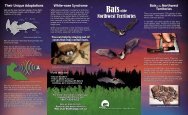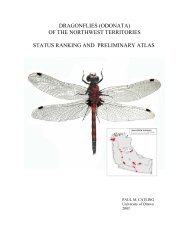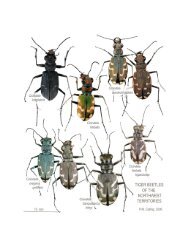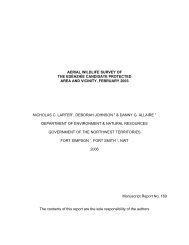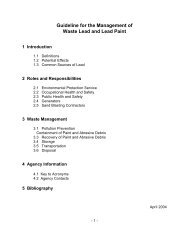Standard Operating Procedure (SOP) - Environment and Natural ...
Standard Operating Procedure (SOP) - Environment and Natural ...
Standard Operating Procedure (SOP) - Environment and Natural ...
- No tags were found...
You also want an ePaper? Increase the reach of your titles
YUMPU automatically turns print PDFs into web optimized ePapers that Google loves.
<strong>St<strong>and</strong>ard</strong> <strong>Operating</strong> <strong>Procedure</strong> (<strong>SOP</strong>)<br />
Capture, H<strong>and</strong>ling & Release of Bears<br />
Wildlife Care Committee Primary Author: Dr. Marc Cattet Version 2 - 2011<br />
Otherwise, unattended bears are susceptible to physiological<br />
complications that might easily be prevented or treated if monitoring<br />
was provided. If more than one capture is planned, the second bear<br />
should not be darted until the first bear darted is immobilized <strong>and</strong> its<br />
welfare has been assured. For helicopter-assisted captures, this<br />
would require l<strong>and</strong>ing the helicopter <strong>and</strong> assessing the physiologic<br />
status of the first bear prior to capturing the second bear where<br />
safety of personnel allows. This approach is not recommended for<br />
polar bear family groups where the dependent offspring usually<br />
remain in close contact to their immobilized mother.<br />
• When a breeding pair is captured, the male should always be<br />
immobilized first in case circumstances change <strong>and</strong> the other<br />
bear cannot be immobilized.<br />
Females generally leave the capture area immediately, but males<br />
may return <strong>and</strong> endanger the immobilized female or capture crew<br />
(Reynolds et al. – unpublished report).<br />
• If capturing a family group, the adult female should be<br />
immobilized first, <strong>and</strong> then the young.<br />
Yearlings <strong>and</strong> older sub-adults should be captured using remote<br />
drug delivery, whereas cubs-of-the-year should be captured by<br />
h<strong>and</strong>, restrained, <strong>and</strong> administered drug by h<strong>and</strong> injection. An<br />
exception to this is large polar bear cubs that should be<br />
administered drug by pole syringe, blowpipe or pistol. A spotting<br />
aircraft may be required to monitor the movement of the dependent<br />
young while their mother is immobilized <strong>and</strong> assessed. If there is no<br />
intent to capture the dependent young, no attempt should be made<br />
to herd the cub(s) back to the capture site. Harassment of the<br />
offspring by aircraft decreases the probability the family will re-unite<br />
(Reynolds et al. – unpublished report). Since yearling (or older<br />
dependent) polar bears usually remain close to their mother when<br />
she is immobilized, it is necessary to dart <strong>and</strong> immobilize the<br />
offspring before it is possible to evaluate the welfare of the mother.<br />
The darting should take place from a helicopter <strong>and</strong> should take<br />
place as soon as the mother is immobilized; the goal being to<br />
immobilize the offspring as quickly <strong>and</strong> safely as possible (Holtby<br />
2005 – unpublished report). The helicopter should approach from a<br />
high altitude (≥100m above ground level) <strong>and</strong> hover above the<br />
family group. The pilot should then descend the helicopter vertically<br />
into shooting position approximately 5-10m above the family group.<br />
If there is more than one offspring, the shooter should be prepared<br />
to dart each bear on the first approach; that is, the required number<br />
of darts should be filled with the required dose <strong>and</strong> ready to load<br />
into the delivery system. If the offspring flee during the vertical<br />
descent of the helicopter, the pilot should be prepared to herd the<br />
young back to the mother <strong>and</strong> attempt another vertical descent. If<br />
the offspring continue to run each time a vertical descent is<br />
attempted, it may be necessary to use the same approach<br />
9



